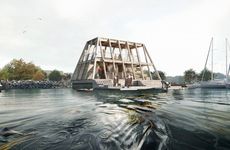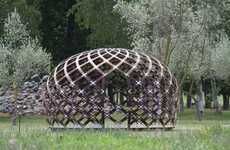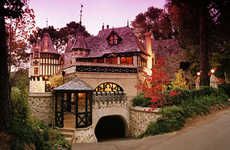
The Bloom Phytoplankton Farm Creates a Pleasant Environment for People
Amelia Roblin — April 1, 2013 — Eco
References: sitbonarchitectes & plusmood
Based on the anticipation for a possible rise in sea levels by around 16 centimeters, the Bloom Phytoplankton Farm endeavors to cleverly deal with global warming in the year 2050. Designed by Sitbon Architectes and intended for situation in the Indian Ocean, this project solves many problems in one innovative spherical shell.
The semi-submerged ball would be anchored to the sea bed, constantly monitoring the swell to determine tsunami activity. Inside, the enclosure houses several tanks and a structure that supports a culture of algae, absorbing excess carbon dioxide and releasing valuable oxygen.
The much-impacted continent of Asia will also benefit from built environments such as the Bloom Phytoplankton Farm, with so much land having been swallowed up by sea. This floating aquatic center would offer leisure areas like swimming pools, all accessed by boats.
The semi-submerged ball would be anchored to the sea bed, constantly monitoring the swell to determine tsunami activity. Inside, the enclosure houses several tanks and a structure that supports a culture of algae, absorbing excess carbon dioxide and releasing valuable oxygen.
The much-impacted continent of Asia will also benefit from built environments such as the Bloom Phytoplankton Farm, with so much land having been swallowed up by sea. This floating aquatic center would offer leisure areas like swimming pools, all accessed by boats.
Trend Themes
1. Sea Level Rise Adaptation - The Bloom Phytoplankton Farm addresses the challenge of rising sea levels by creating a semi-submerged ball that can monitor tsunami activity and house algae to absorb excess carbon dioxide.
2. Carbon Offsetting Technologies - The concept of utilizing algae to absorb excess carbon dioxide presents an opportunity for the development of innovative carbon offsetting technologies.
3. Floating Aquatic Centers - The design of floating aquatic centers, such as the Bloom Phytoplankton Farm, could revolutionize coastal leisure and infrastructure development.
Industry Implications
1. Architecture and Design - Architects and designers can explore new possibilities in adapting to rising sea levels through innovative structures like the Bloom Phytoplankton Farm.
2. Environmental Sustainability - The concept of using algae to absorb carbon dioxide opens up avenues for the development of sustainable solutions to combat climate change.
3. Recreational Industries - The creation of floating aquatic centers presents new opportunities for the leisure and tourism industries, particularly in coastal regions affected by rising sea levels.
4.6
Score
Popularity
Activity
Freshness























